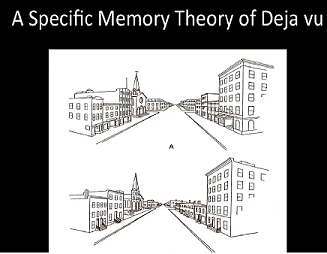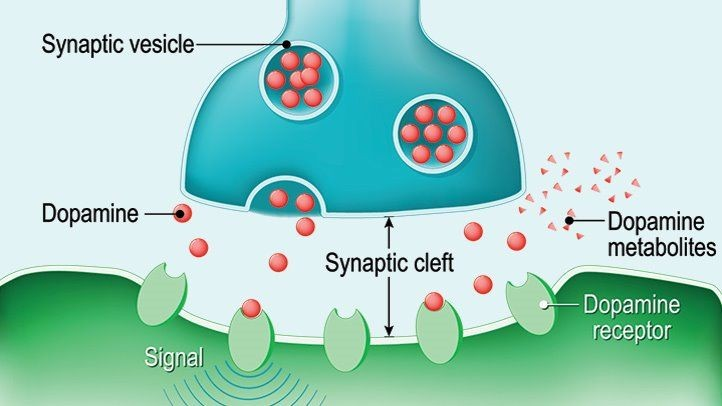Dejavu is the feeling that you have already experienced something that is actually happening for the first time. Mental illusion is a false mental image produced by misinterpretation of things that actually exist. Hallucination is an experience involving the apparent perception of something not present. Crypto amensia is an implicit memory phenomenon in which people mistakenly believe that a current thought or idea is a product of their own creation when, in fact, they have encountered it previously and then forgotten it. Glitch is a minor problem that causes a temporary setback. Reincarnation is the rebirth of a soul in another body. Dreams is a series of thoughts, images, and sensations occurring in a person's mind during sleep. Fragment is a small part broken off. Hyperdopaminergic is excess secretion of the Dopamine (Neurotransmitter).
- Brain cognition cognitive psychology
- Brain
- cognitive psychology
- cognition
- Excess dopamine secretion,
- Dejavu
- Brain glitch
- Confusion
- Hallucination
- Psychiatric Illness,
- Hologram theory
- Cross-referencing
- Crypto amnesia
- Re- incarnation,
- memory-reconstruction
1. Introduction
In general, The Dejavu is mostly experienced by an individual in his own mind. There is no particular time or date when it is going to happen. So, proving the Dejavu is a marathon task. Well, few researchers are ongoing to prove this in lab settings but there is no certainty this has ultimately led to an evolution of the key concepts negotiated below.
If you have gone to a different place or If you have met someone or If you have undergone the smell you sense, the food you taste, the sound you hear, the touch you feel, the view of your eye which you see for the first time but you will be perceiving this has happened long back ago, this strange feeling is known as the Deja vu. In general, the Deja vu was coiled from the French word which means “already seen”. It is defined as a feeling of having already experienced the present situation. It is generally experienced by 60-80.
In general, it is mostly experienced by the teenagers and young generation. It is recognized in two types: The Pathological Deja vu which generally includes (epilepsy/
neurological /hallucinations/psychiatric illness) and The non-pathological dejavu- ( exploring people-the people who adore traveling / Filmophile- the person who watches more movies ). It was thought proved experimentally to a certain level but not accurately which leads to the formation of different theories.
2. The Famous Theories of the Deja vu Are As Followed
Unconscious Theory
In general, our brain is a complex machine that works without making any sound well it has many compartments where there are many empty spaces where an individual doesn’t open every compartment in their whole life, the brain has such a capacity that it can play even 3 million characters without a hassle. When we are conscious we store the information through our senses and respond to the surroundings. However, our brain when is in an inactive state even though we perceive things, for instance, our eye is a camera of our whole body when we are in an unconscious state our eye will store the information that it sees. When we are inquisitive about something our brain will imagine the same behind our consciousness which will undergo to subconscious state which matches ups everything this is generally termed a mental illusion. Many people will ask whether this dejavu is really present and yes it is present but it is in the following conditions: well 90 percent of this is due to the psychological process whereas 8 percent may be due to the out of control but 2 percent of the people in the whole population would experience such Deja vu.
Your Brain Is Taking a Shortcu
According to Neuroscience experts, it is due to the shortcuts in the narrow pathway. It is generally possible when we experience something that recalls a fragment of an old memory. Our brain interprets that the new experiences are needed to be placed in the long-term memory rather than short-term memory. That is memories are stored directly in the cerebral cortex instead of the hippocampus.
It Could Be an Actual Memory
Anne Cleary, a cognitive psychology professor at Colorado state university, says that “The old memories might still play a role, If not it is very vital for the cause dejavu”. If you have done something long back ago and forget but it might be lingering in small parts of the brain. for instance, as shown in the figure a person who is crossing panel 2 for the first time might have experienced the Deja this is because he might have crossed panel 1 in his previous experience which looks analogous. This triggers a strong sense of familiarity even though we can’t recall any of the details. This theory is said but couldn’t be tested but for the first time, it has been done in a laboratory by using the theory of spatial resemblance.

Figure 1. Panel A and Panel B
May Our Brain May Be Confused
Generally, our brain passes about 100 billion neurons, each firing off 5-50 messages (action potentials) per second these action potentials will assist in transferring the information from one neuron to the other neuron. If only one neuron sends 50 messages within a second then what about the other neurons? this leads to gathering a vast amount of information in our brains. while the process of transferring a huge amount of information, we sometimes fail to process or uptake the information.
According to the scientist Dr.Alice Medalia from the Columbia university medical center, think that if a person is experiencing a Deja Vu he might be undergoing a different saturated state. In simple terms, we can say that the particular movement of our brain is unable to process properly with multiple pieces of information. which leads to falls into Deja Vu.
Maybe Your Brain Is Glitching
Well, our computers may glitch sometimes due to some of the technical issues, Correspondingly our also glitches too, which is a result of the Deja Vu. According to researchers at Texas A and M, our brain generally stores memories in the same part of the brain which is responsible for the detection of familiar places, people, and different events. Most probably, we will be getting Deja vu because for just a moment our brain malfunctions. It is possible for the neurons responsible for the detection of familiarity are firing even though there isn’t anything familiar around our surroundings. This leads to the sensation that we are experiencing the past when we are present in the current situation.
The Hologram Theory
For better understanding purposes let’s exemplify that when you go with your car for a long ride and play music with your friends and view different places through window glass. Then you suddenly perceive that this has already happened in your life long back ago and start thinking about it.

Figure 2. Driving a car.
This is the sort of thing you would file away in your brain’s catalog of information. Then when you have that similar experience, your brain takes a small fragment of your memory and uses it to reconstruct the memory featuring all five senses. Now, this theory is termed the Hologram theory, because it’s sort of like your brain is a 3D event instead of a 1d event.
As even though the details aren’t accurate your brain may confuse them for real memory which leads to the Dejavu.
One of the inquisitive facts is that we will be experiencing the same taste we eat, the same sound we hear, the same touch we feel, and the same smell we smell will be accurate to the past while we are experiencing this in the present state.
3. Cross-Referencing
To understand this theory we need the experiment which was conducted in 2016, a team of re- searchers at the University of St. Andrews in Scotland used the term associated games to test actually which part of the brain is active during experiencing the Deja vu.
The arrangement of Dejavu in a lab setting but according to a new scientist, findings were inconsistent with “the fake memories”. Cause by memory. If the real cause of the Deja vu was the memories that are stored in our brain then which part of the brain would be active? later the active part of the brain which is responsible for the Deja vu was the frontal part which was found in the scans by the scientists. Well, the frontal part of the brain is responsible for decision-making but not for remembering the memory of the brain. So all in all, they said that “the events you have just experienced against the events that you think you have experienced”. If there is any memory error, this will send a signal that leads to the Deja vu.

Figure 3. The frontal part is essential for dejavu.
The Sign of the Young Brain
According to Scientific American the young generation and adolescents aged (12 to 20), experience the Deja vu. This is a sign of a healthy Healthy brain memory against experience and filing everything away for future reference. Well, this is also experienced by the Old aged people –but they don’t have the capability in perceiving the difference between false and true memory.
Crypto amnesia
To explain this concept let us assume that when we hear some word in our past and totally forgot about the word but when he/she comes again comes across that particular word then they will be thinking that they have already know this term. It means that a part of the information is already lingering in our brains. So that’s why we will be showing a certain level of recognition. And there is another statement is that what do we think of memories are just a recollection but researchers said that it is reconstruction and the paranormal and indicative of spirituality.
The Science behind the Deja Vu
Researchers believe it is a memory phenomenon. A scenario is similar to actual memory but fails to recall it. Our brain is the activation of the feeling of familiarity without triggering the area of memory. It is due to synaptic misfiring that might occur in these areas. Creating an illusion that the event has happened before. So that’s why Temporal lobe epilepsy often experiences Deja Vu. The abnormal discharge of electrical impulses especially in teenagers. A malfunction of long and short circuits in the brain that is new information can take short cut straight to long-term memory.
Islamic Script
Generally, according to the Hindus, it is considered that if a person is dead then he will be having reincarnation. But as considered the Islamic script says that "If a person is dead, he will not be having reincarnation instead it says that he will be judged to go to heaven or hell." Well, this Deja vu is explained certainly but not exactly in the Quran. So, the final explanation is that the future of a person is seen in his dream. So, for instance, If a person is sitting in a class and sees everywhere, then he/she suddenly recalls by closing their eyes and perceive that some tragedy is going to happen then if it happens then they will fall into Deja vu.
Spiritual Significance
Some researchers like Dr. Lan Stevenson a pioneer in past life memories suggest that this can be proof of past life existence. That is what we have experienced in a previous life we again undergo a similar stitch in this life and that’s why we have experienced this. Of course, it is one possibility but no certainty of strong life existence.
The children have past life memories that are verifiable recognition and behavior is a much stronger piece of evidence. Especially behaviors associated with it. Children have the capability of recognizing their past life people and places and behaving as if they were behaving in their previous life and their birthmarks are proof.
proof from Bhagavad Gita chapt
vasansi jirnani yatha vihaya navani
grihnati naro parani tatha
sharirani vihaya jirnanya
nyani sanyati navani dehi
As a person sheds worn-out garments and wears new ones, likewise, at the time of death, the soul casts off its worn-out body and enters a new one.
4. History of Dejavu
pharmacology:-
Release of the excess dopamine.
In pharmacology, the cause is due to the people who have epilepsy who undergoes, an especially temporal seizure will mostly experience Deja Vu.
In 2001, Tamminen and Jaaskelainen reported that healthy males started experiencing the in- tense and recurrent sensation of Deja Vu upon taking amantadine, and phenylpropanolamine together to relieve flu symptoms.
At last, Tamminen and Jaaskelainen speculate that it is a result of hyperdopaminergic (excess release of dopamine in the body) action in medial temporal areas of the brain.

Figure 4. Releasing Excess of Dopamine.
5. Conclusion
Eventually, these all are the different types of Deja Vu theories that anyone of us might have experienced at any time in our lives. This strange feeling is crazy which says our brain is working in exuberant condition. In addition to that it is a sign of warning for the people who may get epilepsy in the future. One of the most inquisitive facts which I felt was that Dreams which are mostly seen while sleeping will appear analogous to a particular situation [1][2][3][4][5][6].
References
- Brainerd C J , Reyna V F, Ron Wright, Mojardin A H,(2003)," Recollection rejection: False-memory editing in children and adults." American Psychological Association,110(4), 762–784.
- Connor A. and Moulin C.(2013)'Déjà vu experiences in healthy subjects are unrelated to laboratory tests of recollection and familiarity for word stimuli' frontiers in psychology,4: 881
- CHAPMAN A H, MENSHA I N,(1951)"Déjà vu experience and conscious fantasy in adults" National Library Of Medicine"25(2):163-75.
- Cleary A.(2022) "What is déjà vu? Psychologists are exploring this creepy feeling of having already lived through an experience before" The conversation.
- E Wells C, R O'Connor A, J A Moulin, C (2021) "Déjà vu experiences in anxiety" National Library Of Medicine,29(7):895-903.
- Richardson T. F, Winokur G, MD. (1967) "Dèjà Vu in Psychiatric and Neurosurgical Patients" A JAMA NETWORK PUBLICATION 17(5):622-625.
